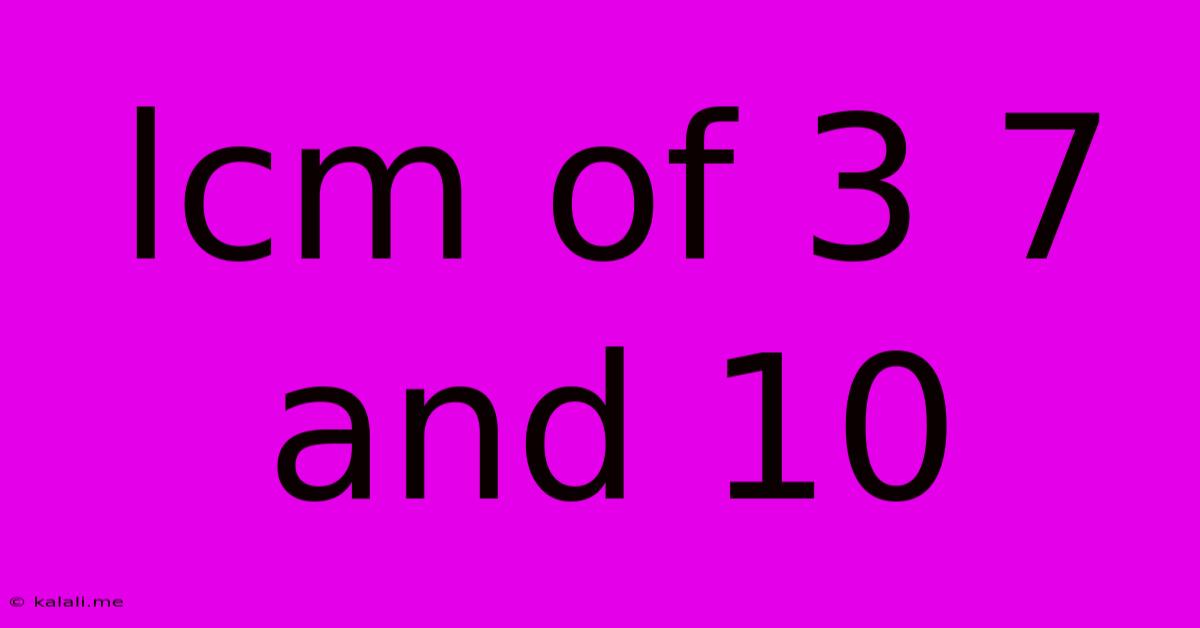Lcm Of 3 7 And 10
Kalali
Jun 14, 2025 · 3 min read

Table of Contents
Finding the Least Common Multiple (LCM) of 3, 7, and 10
This article will guide you through calculating the Least Common Multiple (LCM) of 3, 7, and 10. Understanding LCM is crucial in various mathematical applications, from simplifying fractions to solving problems involving cycles and patterns. This tutorial will break down the process, explaining the concepts clearly and providing a step-by-step solution.
What is the Least Common Multiple (LCM)?
The Least Common Multiple (LCM) is the smallest positive integer that is a multiple of two or more integers. Think of it as the smallest number that all the given numbers can divide into evenly. For example, the LCM of 2 and 3 is 6, because 6 is the smallest number divisible by both 2 and 3.
Finding the LCM is particularly useful when dealing with fractions, solving problems related to cyclical events (like figuring out when two events will occur simultaneously again), and in various other mathematical contexts.
Methods for Calculating the LCM of 3, 7, and 10
There are several ways to determine the LCM, but we'll focus on two common and effective methods: the prime factorization method and the listing multiples method.
Method 1: Prime Factorization
This method involves breaking down each number into its prime factors. A prime number is a whole number greater than 1 that has only two divisors: 1 and itself.
-
Find the prime factorization of each number:
- 3 = 3 (3 is already a prime number)
- 7 = 7 (7 is already a prime number)
- 10 = 2 x 5
-
Identify the highest power of each prime factor:
- The prime factors we have are 2, 3, 5, and 7.
- The highest power of 2 is 2¹
- The highest power of 3 is 3¹
- The highest power of 5 is 5¹
- The highest power of 7 is 7¹
-
Multiply the highest powers together:
- LCM(3, 7, 10) = 2¹ x 3¹ x 5¹ x 7¹ = 2 x 3 x 5 x 7 = 210
Therefore, the LCM of 3, 7, and 10 is 210.
Method 2: Listing Multiples
This method is more intuitive but can be less efficient for larger numbers. It involves listing the multiples of each number until you find the smallest common multiple.
-
List multiples of each number:
- Multiples of 3: 3, 6, 9, 12, 15, 18, 21, 24, 27, 30, ..., 210
- Multiples of 7: 7, 14, 21, 28, 35, 42, 49, 56, 63, 70, ..., 210
- Multiples of 10: 10, 20, 30, 40, 50, 60, 70, 80, 90, 100, ..., 210
-
Find the smallest common multiple:
By comparing the lists, you'll find that the smallest number that appears in all three lists is 210.
Therefore, the LCM of 3, 7, and 10 is 210.
Conclusion
Both methods yield the same result: the Least Common Multiple of 3, 7, and 10 is 210. The prime factorization method is generally more efficient for larger numbers, while the listing multiples method is more straightforward for smaller numbers. Understanding these methods equips you with valuable tools for solving various mathematical problems involving multiples and common factors. Remember to choose the method most suitable for the numbers you're working with.
Latest Posts
Latest Posts
-
Excel Showing Formula And Not Result
Jun 15, 2025
-
University Of Rhode Island Gpa Requirements
Jun 15, 2025
-
How Hot Is 200 Celsius In Fahrenheit
Jun 15, 2025
-
Least Common Multiple Of 32 And 40
Jun 15, 2025
-
What Are Factor Pairs Of 32
Jun 15, 2025
Related Post
Thank you for visiting our website which covers about Lcm Of 3 7 And 10 . We hope the information provided has been useful to you. Feel free to contact us if you have any questions or need further assistance. See you next time and don't miss to bookmark.